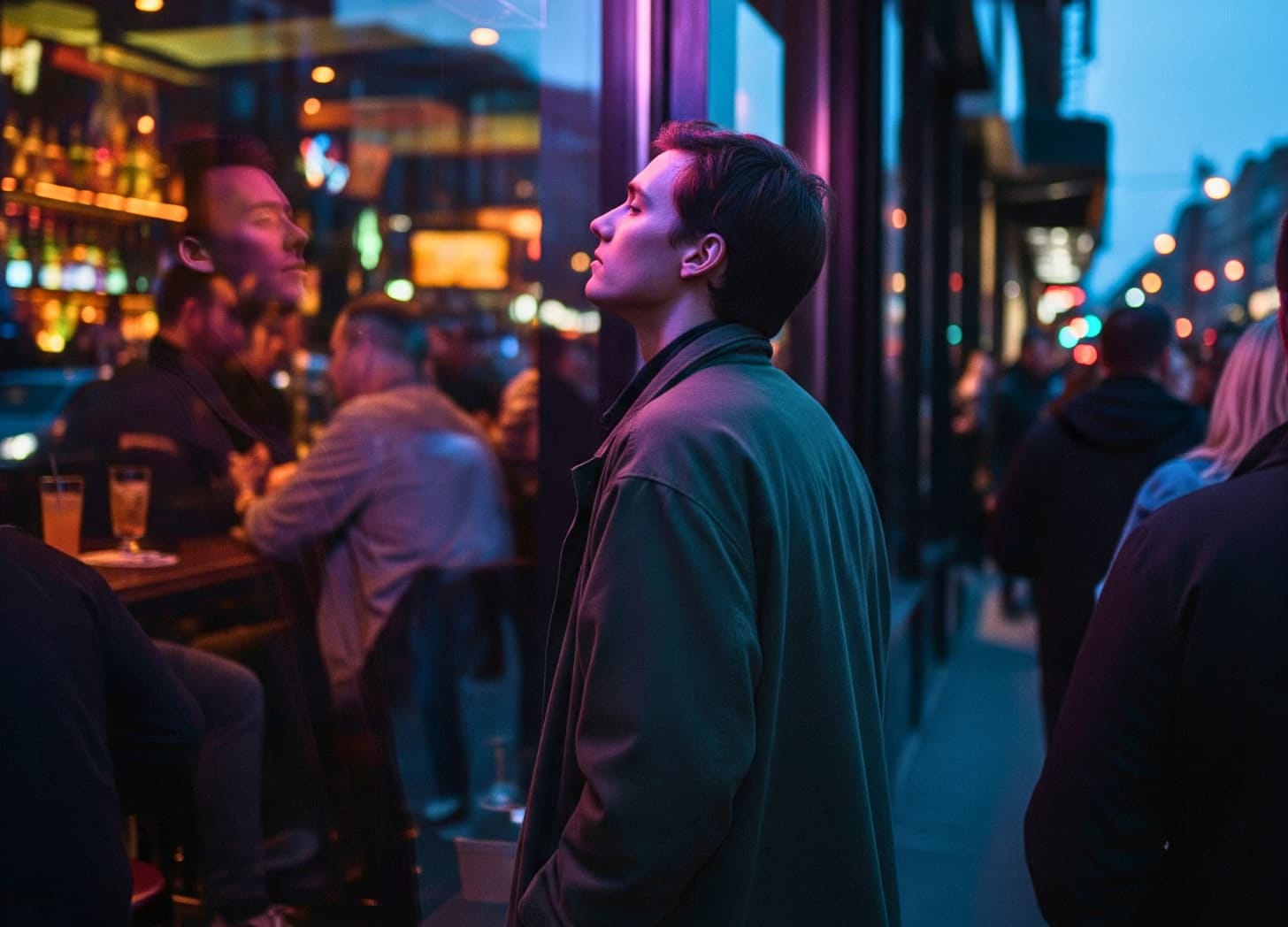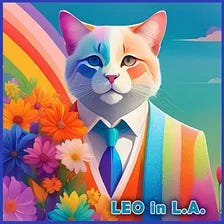When "Gay Enough" Isn't the Question: Living in the Quiet Middle
A deeply personal reflection on queer imposter syndrome, identity friction, and the quiet middle where many LGBTQ+ people live.
The message arrived at 12:54 AM my time. That hour when even Gmail seems to whisper.
Leo had just read my post about queer imposter syndrome, about the fear of not being "gay enough," and messaged me privately.
He described identifying as non-binary while living in a cis male body. His brain wired more like the women he'd known than most men, gay or straight. He didn't lean masculine or feminine, didn't want to change his body. But he'd always struggled to relate to other gay men.
"I never felt like I was gay enough," he wrote. "Being at the intersection of non-binary and gay can have the same othering impact. Not relating to gay men, and not relating to straight men."
I sat with that line longer than I expected. Not because it surprised me. Because it put language to something I've felt and seen in others for years. The ache of not fitting even within the communities that claim you.
Then came the part that really struck me. Leo echoed a line from my piece about "misdiagnosing the friction as personal failure" and replied, "That is SPOT ON."
Hearing those words reflected back, I felt something settle. Not because they were new. Because they'd landed. Someone else had felt it too.
I closed my laptop. Stared at the ceiling. Remembered.
The Architecture of Almost
My first time walking into a gay bar. I don't recall what I was wearing, only how I felt. Like everyone else had gotten a memo I'd missed.
They seemed to know how to move, how to talk, how to touch each other's arms mid-sentence in a way that didn't feel accidental. I stood near the edge of the crowd, drink in hand, trying to decode it all. When to laugh, when to flirt, when to pretend not to notice someone you definitely noticed.
My body had already learned its habit. Take up less space, don't draw attention, look like you belong.
That posture stayed with me. Too gay for straight spaces. Something gave me away. Perhaps my softness unsettled people. But in gay spaces? I wasn't buff enough for the clubs. Not flamboyant enough for the theatre kids. Not loud enough for the activists.
I hovered in the middle. What Leo helped me remember: the quiet middle. That space between two extremes where both sides tell you you're not quite right.
When Even the Umbrella Has Borders
Leo's message unlocked something I'd been avoiding. How we queer folks build shelters from straight rejection, then install new doors with different locks.
Take the ongoing debate about who belongs under the trans umbrella. Some say non-binary identities are inherently trans.
"Something I've never understood," Leo wrote, "is why our community wants to label non-binary as under the trans umbrella. Trans is transition. It's the goal of a destination where the person wants to stay there. That is not the goal for non-binary. The actual definition of the word means we don't have a destination and that there's fluidity. There is no transition. That's part of the gatekeeping."
Others insist you need dysphoria, medical transition, a certain level of suffering. People like Leo exist in the spaces between definitions. Their reality gets invalidated by arguments about categories they never asked to join or leave.
I thought about a client (a composite of many) who described it perfectly: "I went to a support group for trans folks. Someone asked my pronouns, I said they/them, and the room got quiet. Not hostile, just recalibrating. Like I was a software update they weren't sure they wanted to install." They had a way with words.
Where the Friction Lands
The patterns repeat everywhere. Masculine gay men writing "no fats, no femmes" like it's a rational preference rather than internalized hatred. Lesbian spaces debating whether trans women belong. Bisexual erasure so complete we don't even call it erasure anymore. Just another day.
And in these battles over authentic queerness, people like Leo disappear. They can't point to dramatic coming out stories or clear category membership. They exist in what he called the othering impact. Not relating to gay men, not relating to straight men.
Where do you feel the friction of not fitting? Is it a tightness across your chest? A weight in your stomach? I ask this because the body remembers when we're constantly explaining ourselves, constantly proving we belong somewhere we're already standing.
The Suburbs Were Always Queer
One line from Leo cracked something open:
"Perhaps it's a byproduct of being shoehorned into a marginalized community that doesn't leave room for the suburbs and minivans, and for valuing other things than Fire Island and gym memberships."
I thought about the kinds of queer lives that rarely make it into campaigns or Pride videos. Quiet, ordinary ones. Two men who've built a life together but never needed to post about it. People who live in rented houses with rescue dogs, or plan Sunday meals, or hold hands only when no one's looking.
Not all of us want to dance on floats. Some of us just want to belong somewhere that doesn't ask us to perform.
Maybe Leo's suburban dreams aren't a betrayal of queerness but its natural evolution. Maybe the minivan is just another way of saying: I want a life that holds all of me, even the parts that don't photograph well at Pride.
Leo shared that he has a lovely, happy life with his husband of over 30 years. He added, “For me personally, it’s not so much refusing to be remarkable, as it is not needing to be the community’s idea of remarkable.” The satisfaction of a quiet, unique life, he said, doesn’t require community validation.
In sessions over the years, I've heard this echo repeatedly. The non-binary person who loves NFL Sundays. The gay man who genuinely enjoys his accounting job. The lesbian who shops at Target and doesn't want to apologize for it.
They arrive carrying shame about their "boring" lives, as if queerness requires perpetual performance of difference.
But ordinariness might be its own resistance. Refusing to be remarkable could be the most radical thing of all.
The Violence of Visibility
Here's what we don't say enough: visibility can become its own cage. When queerness gets reduced to aesthetic markers (the right references, the right presentation, the right kind of struggle), we lose everyone who exists outside those boundaries.
Leo mentioned how non-binary visibility is often flattened into androgynous presentation or social media performance. For people like him, the experience is quiet, embodied, internal.
Their invisibility isn't accidental. It's architectural.
The cruelest part? This invisibility gets misread as privilege. "You can pass," people say, as if erasure were a superpower. As if being unrecognizable to your own community were a gift rather than its own kind of exile.
Scrolling through Instagram pages, many of my clients search for anyone who looks like them. Lives like theirs. They find endless posts about being proud and visible, but nothing that reflects their quiet, ordinary existence.
The particular grief of being told you're welcome while being shown you don't exist.
Professional Patterns
After over a decade in practice focused on LGBTQ+ mental health, I've noticed something. The clients who struggle most with "not being queer enough" are often the ones living the most integrated lives.
They're not performing queerness or straightness. They're just existing. And that terrifies everyone invested in clear categories.
A pattern emerges: They enter therapy convinced they're failing at identity. We spend months unpacking the truth. Identity isn't failing them. The frameworks are.
One person put it this way: "I kept trying to make myself fit the shape of proper queerness. Like squeezing into jeans from high school. Then I realized, maybe I'm not the wrong size. Maybe the jeans are."
The Quiet Middle
What I've come to call the quiet middle isn't emptiness. It's fullness that resists categorization. It's the place where most of us actually live, between the spotlights of acceptable identity.
I think about my own evolution. How I spent years trying to be gay enough, masculine enough, political enough. How exhausting it was, carrying all those enoughs like groceries with breaking bags.
The relief when I finally set them down. Not in some dramatic moment of self-acceptance, but gradually. Day by day. Until one day I noticed I was just living.
The middle isn't failure to reach the edges. It's its own location, with its own weather, its own language, its own way of being in the world.
The Friction as Intelligence
Leo's message reflected back something I've heard in so many forms. This friction we feel is often mistaken for failure when really, it's a signal.
Your body knows that forced categories don't fit. You refuse to perform identity for anyone's comfort, including your own community's.
Recently, walking through my neighborhood, I passed a house with both a pride flag and a lawn gnome. The combination made me smile. This is what integration looks like: not choosing between queer and conventional, but letting them coexist without explanation.
Maybe the things we've been taught to see as compromises aren't betrayals of queerness at all. Suburbs, minivans, quiet domestic rhythms. Maybe they're completion.
The station wagon in the driveway. The they/them pronouns at work. The flannel that's just comfortable clothing, not a signal.
A life that doesn't translate easily to Instagram squares or pride-parade floats but hums with its own frequency of authenticity.
Finding Each Other
If Leo's story mirrors yours, drop a comment or message Leo privately. Perhaps this post will help quiet-middle folks find one another.
He ended one of his messages with something that stayed with me:
"I shared some of your writing with my therapist and she loved it. I think your writing would help other therapists understand our community."
I replied to his 12:54 AM message while on a lunch break, when the world feels most honest. I didn't try to fix anything. Just named what I saw: that the absence of language had left many of us misdiagnosing friction as personal failure. That maybe what he was calling confusion was actually integrity, refusing to contort himself to fit gay or straight scripts.
I told him the quiet middle isn't emptiness. It's the place we were never taught to name, but have been living in all along.
Did this post resonate or clarify something you’ve been circling? Please restack or share it.
The more we surface these shared patterns, the less isolated we feel inside them. That’s why I write. Not to give answers, but to make it harder to look away.
Meet Leo in LA:
Leo is a professional writer living in his forever home in the hills of Los Angeles, with his husband of 30+ years. World travelers and sushi-eaters, they prefer the quiet life with one perfect cat, a charm of hummingbirds, and an infestation of demanding but adorable squirrels.
Disclaimer:
This newsletter is for educational and informational purposes only. It does not replace therapy, diagnose, treat, or prevent any condition. For info here.







I'm reading this at 5AM after waking up a half hour before my alarm was set to go off. It resonated so much. I frequently don't feel "gay enough" - being in what could pass as a straight appearing marriage with a non-binary partner. In some ways, I feel completely guilty for that privilege, especially in these times, but it's also just the way my life turned out. Instead of coming out in the 90s, I got married instead because, as I so frequently say, I couldn't see a path forward that included both being an out gay man and being happy. That was a false choice, for sure, but the 90s were different than now. Some may call me cowardly, but I was just doing the best I could with the information I had at the time. My partner bears me no ill will and we've supported each other through our respective coming outs.
I guess what I'm trying to say is that I'm learning - slowly - that there's no one right way to be gay. And that, for me, is the biggest lesson of all.
"That maybe what he was calling confusion was actually integrity": Yes!